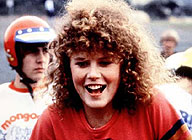|
|
|
|
BMX
Bandits
|
 |
|
The opening establishing shot of BMX Bandits is a typical panorama of a North Sydney beach suburb. Then, surprisingly, it jumps to a stylised montage of close-up detail, as a young BMX rider straps on his gear and launches himself into the world. This wonderful beginning places the film firmly in the tradition of those teen movies worldwide which are about ordinary, suburban kids working their city – intimately knowing its streets, escape routes, nooks and crannies. The downbeat reality of workaday suburban life is thus played off against the momentary, ecstatic transcendence provided by bike riding (for an American treatment of this theme, compare Quicksilver [1986]). BMX Bandits, in its confident mixture of local detail (particularly its use of droll, ocker humour) with an internationally used generic form, is indeed one of the most artistically successful Australian teen movies. The film relates to a teen road movie tradition inaugurated by American Graffiti (1973) and continuing through films like Corvette Summer (1978), Longshot (1981) and The Wizard (1989), rather than the high-energy teen movies of John Hughes. It shows teenagers not in the home but perennially cruising streets, diners, and secret haunts. A special feature of this tradition is the affectionate, whimsical, slightly radical emphasis on the open, shifting group relations of people in their early teens, as distinct from the one-on-one sexual attachments of later adult life. As Judy (Nicole Kidman) says of her friendship with P.J. (Angelo D'Angelo) and Goose (James Lugton): "You know what they say – two's company, three gets us talked about." Like most of Trenchard-Smith's films, it is fast, well-modulated, and very economically devised. The central narrative device (again familiar from teen road movies like The Legend of Billie Jean [1985]) is a simple communications gadget (the walkie-talkie) which links all the characters, allowing them to 'cover' their town. Since their signal can also be picked up by the police and villains alike, the action-adventure moves in the story are extremely well articulated, setting up several thrilling chase sequences. One of the most notable and pleasurable aspects of the film is the way it weaves references to movies, TV and popular culture into the integral fabric of the story. Early on, Goose relates his love of gory "horror road movies", cueing a comic-eerie chase scene set in a cemetery at night. Later, Judy invents a hilarious pastiche of teen-horror movies in order to distract her captors. And many of the film's bad guys – whether criminals or cranky, unjust bosses at suburban worksites – seem culled from British TV, a source cued by David Argue's Minder T-shirt. This perceptive mix of American and British pop culture references is rare in Australian cinema. As in many a teen movie the tone is kept light, whether a scene is devoted to bloodless action, mild slapstick comedy or innocently romantic character interaction. The action component is particularly expertly handled, balanced between, at one extreme, the ever-present hint of malicious psycho violence inherent in Argue's screen persona, and at the other non-violent knockabout gestures like an army of kids on bikes pelting the villains with flour. Such lightness of tone has, of course, consigned BMX Bandits to critical oblivion as a mere kids' film, lacking drama or meaning. Yet, appreciated as a teen movie, it is intricate, entertaining and often disarming. Within its own terms, it is one of the most perfectly realised Australian films of the '80s. MORE Trenchard-Smith: Jenny Kissed Me MORE pre-teen movies: Spy Kids, Spy Kids 3D: Game Over, Max Keeble's Big Move MORE Australian teens: Lex and Rory, The Still Point, Secrets, The Heartbreak Kid, Looking for Alibrandi © Adrian Martin 1991 |
![]()